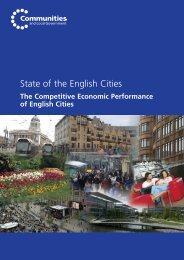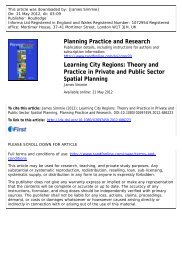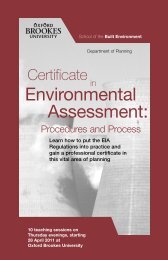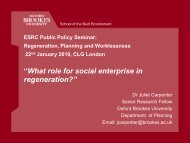History Matters: Path dependence and innovation in British city ...
History Matters: Path dependence and innovation in British city ...
History Matters: Path dependence and innovation in British city ...
You also want an ePaper? Increase the reach of your titles
YUMPU automatically turns print PDFs into web optimized ePapers that Google loves.
• Tak<strong>in</strong>g advantage of chance events lead<strong>in</strong>g<br />
to the open<strong>in</strong>g of locational w<strong>in</strong>dows of<br />
opportunity.<br />
• Improv<strong>in</strong>g the productivity of exist<strong>in</strong>g<br />
bus<strong>in</strong>esses.<br />
• Break<strong>in</strong>g out of technological lock-<strong>in</strong>.<br />
• Creat<strong>in</strong>g new <strong>in</strong>stitutions.<br />
• The <strong>in</strong>troduction of new social structures.<br />
The available data only allow us to <strong>in</strong>vestigate<br />
a few of these characteristics. One way to<br />
analyse local new knowledge creation is to look<br />
at patent data. Although this casts light ma<strong>in</strong>ly<br />
on high-tech manufactur<strong>in</strong>g <strong>in</strong>dustries, it does<br />
provide an <strong>in</strong>dicator of new knowledge creation<br />
<strong>in</strong> this area.<br />
Figure 13 shows the changes tak<strong>in</strong>g place<br />
<strong>in</strong> the annual rates of patent applications to<br />
the European Patent<strong>in</strong>g Office (EPO) dur<strong>in</strong>g<br />
the 1990s. This analysis mirrors that shown<br />
<strong>in</strong> Table 2. All the cities that appeared <strong>in</strong> the<br />
top deciles for <strong><strong>in</strong>novation</strong> outcomes <strong>in</strong> CIS4 <strong>in</strong><br />
Table 2 also produced more patent applications<br />
than the average for Engl<strong>and</strong> dur<strong>in</strong>g the<br />
1990s. Conversely all those <strong>in</strong> Table 2 that<br />
appeared <strong>in</strong> the lowest deciles produced fewer<br />
patent applications than the English average.<br />
While patent applications are an important<br />
element of an LIS <strong>in</strong> their own right, there is no<br />
necessary correlation between the generation<br />
of new ideas <strong>and</strong> their application <strong>in</strong> products<br />
<strong>in</strong> the same <strong>city</strong>.<br />
The adoption of external new knowledge is also<br />
an important source of <strong><strong>in</strong>novation</strong> <strong>in</strong> any <strong>city</strong>regional<br />
economy. Every year the UK spends<br />
some £21 billion on creat<strong>in</strong>g new knowledge<br />
through the science system <strong>in</strong> universities,<br />
research <strong>in</strong>stitutes <strong>and</strong> companies. But this<br />
represents only 3.5 per cent of the total<br />
creation of such new knowledge among OECD<br />
countries (AIM 2008). This re-emphasises the<br />
importance of cities develop<strong>in</strong>g capa<strong>city</strong> to<br />
identify, access <strong>and</strong> assimilate external new<br />
knowledge. In many cases the capa<strong>city</strong> to<br />
adopt new knowledge from elsewhere is likely<br />
to be at least as significant as its <strong>in</strong>digenous<br />
creation.<br />
An important <strong>in</strong>dicator of a <strong>city</strong>’s capa<strong>city</strong><br />
to commercialise locally or <strong>in</strong>ternationally<br />
generated new ideas is the presence of<br />
knowledge-<strong>in</strong>tensive bus<strong>in</strong>ess services (KIBS).<br />
These provide highly specialised contributions<br />
to firms’ whole range of commercial activities<br />
<strong>in</strong>clud<strong>in</strong>g comput<strong>in</strong>g, R&D, technical services,<br />
advertis<strong>in</strong>g, market research, legal, account<strong>in</strong>g<br />
<strong>and</strong> tax services.<br />
Figure 14 shows the relative growth <strong>in</strong> narrowly<br />
def<strong>in</strong>ed KIBS for our sample cities. The<br />
proportion of employees <strong>in</strong> KIBS has <strong>in</strong>creased<br />
most rapidly above the <strong>British</strong> average <strong>in</strong><br />
Read<strong>in</strong>g, with significant <strong>in</strong>creases <strong>in</strong> Aldershot,<br />
Cambridge, Oxford <strong>and</strong> Warr<strong>in</strong>gton. But<br />
the rates of <strong>in</strong>crease <strong>in</strong> the rema<strong>in</strong><strong>in</strong>g cities<br />
except Leeds have not kept pace with the<br />
average. The lowest rates are to be found <strong>in</strong><br />
Swansea, Wakefield <strong>and</strong> <strong>in</strong> Newport (where the<br />
proportions of KIBS actually fell between 1981<br />
<strong>and</strong> 2005).<br />
KIBS face a problem faced by other aspects<br />
of a local <strong><strong>in</strong>novation</strong> system. With limited<br />
numbers of <strong>in</strong>novative firms, dem<strong>and</strong> for<br />
specialised services may be too low to provide<br />
a sufficient market for the development of<br />
specialised KIBS. But without access to local<br />
KIBS potentially <strong>in</strong>novative firms may f<strong>in</strong>d it<br />
difficult to acquire the specialised external<br />
services that they need to meet their <strong>in</strong>novative<br />
potential.<br />
2.6 New pathways are created by<br />
<strong>in</strong>teractions between absorptive<br />
capa<strong>city</strong> <strong>and</strong> <strong><strong>in</strong>novation</strong><br />
We have argued that the ability of <strong>city</strong>regional<br />
economies to change or break out of<br />
historically determ<strong>in</strong>ed development pathways<br />
is, to a significant extent, based on local<br />
capacities to underst<strong>and</strong>, create or adopt <strong>and</strong><br />
commercialise new knowledge. This represents<br />
a complex comb<strong>in</strong>ation of absorptive capacities<br />
<strong>and</strong> <strong><strong>in</strong>novation</strong>. In this section we turn to the<br />
question of how <strong>in</strong>teractive comb<strong>in</strong>ations of<br />
these capacities may lead to the creation of<br />
new pathways. The potential sources of new<br />
path creation <strong>in</strong>clude:<br />
• Indigenous creation.<br />
• Heterogeneity <strong>and</strong> diversity.<br />
• Transplantation from elsewhere.<br />
• Diversification <strong>in</strong>to related <strong>in</strong>dustries.<br />
• Upgrad<strong>in</strong>g exist<strong>in</strong>g <strong>in</strong>dustries.<br />
Indigenous creation<br />
We have already argued that this rests on<br />
the aggregate <strong><strong>in</strong>novation</strong> capa<strong>city</strong> of a given<br />
31













